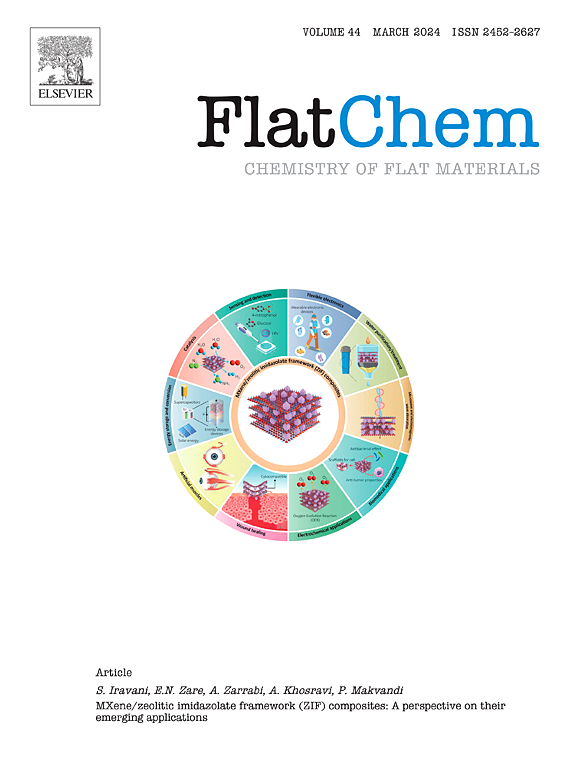具有增强光电催化性能的钒基MXene三元异质结构的高效载流子分离
IF 6.2
3区 材料科学
Q2 CHEMISTRY, PHYSICAL
引用次数: 0
摘要
三氧化钨(WO3)和硫化锌铟(ZnIn2S4)是具有优异光吸收特性的光催化剂。然而,单一光催化剂存在电荷载流子快速重组的问题。为了改善光电催化性能,我们在本文中报告了一种新型 S 型三元异质结构(V2CTx@WO3/ZnIn2S4)的制备方法。由于 V2CTx MXene 具有很高的导电性,它在异质结构中的存在为界面提供了高效的电荷转移动力学。单斜 WO3 和立方 ZnIn2S4 通过 X 射线衍射光谱(包括晶体尺寸和微应变)得到了证实。三元复合材料的光吸收波长发生了红移,带隙能低至 1.58 eV,而 ZnIn2S4 为 2.21 eV,WO3 为 2.55 eV。光致发光和电子阻抗光谱显示,三元复合材料(5% VWZ)具有有效的电荷分离和较低的电荷转移电阻。ZnIn2S4 (6.68 eV)、WO3 (7.08 eV) 和 V2CTx (8.70 eV) 的功函数证实在半导体界面上产生了内部电场。由于结合能的变化,电子从 ZnIn2S4 迁移到 WO3,XPS 数据证实了 S 型异质结构。本文章由计算机程序翻译,如有差异,请以英文原文为准。

An efficient charge-carrier separation in vanadium-based MXene ternary heterostructure with enhanced photoelectrocatalytic properties
Tungsten trioxide (WO3) and zinc indium sulfide (ZnIn2S4) are among photocatalysts with excellent light absorption properties. However, single photocatalyst suffers from rapid charge carrier recombination. For improved photoelectrocatalytic properties, herein, we report fabrication of a novel S-scheme ternary heterostructure (V2CTx@WO3/ZnIn2S4). Due to the high electrical conductivity of V2CTx MXene, its presence in the heterostructure offers efficient charge transfer kinetics at the interface. Monoclinic WO3 and cubic ZnIn2S4 were confirmed by X-ray diffraction spectroscopy including crystallite size and micro-strain. Ternary composites demonstrated red shift in light absorption wavelength, with band gap energies as low as 1.58 eV compared to 2.21 for ZnIn2S4 and 2.55 eV for WO3. Photoluminescence and electron impedance spectroscopy demonstrated effective charge separation with low charge transfer resistance by the ternary composite (5 % VWZ). Work functions for ZnIn2S4 (6.68 eV), WO3 (7.08 eV), and V2CTx (8.70 eV) confirmed the creation of an internal electric field at the interface of the semiconductors. Electron migration occurred from ZnIn2S4 to WO3 due to changes in binding energies as indicated by XPS data confirming S-scheme heterostructure.
求助全文
通过发布文献求助,成功后即可免费获取论文全文。
去求助
来源期刊

FlatChem
Multiple-
CiteScore
8.40
自引率
6.50%
发文量
104
审稿时长
26 days
期刊介绍:
FlatChem - Chemistry of Flat Materials, a new voice in the community, publishes original and significant, cutting-edge research related to the chemistry of graphene and related 2D & layered materials. The overall aim of the journal is to combine the chemistry and applications of these materials, where the submission of communications, full papers, and concepts should contain chemistry in a materials context, which can be both experimental and/or theoretical. In addition to original research articles, FlatChem also offers reviews, minireviews, highlights and perspectives on the future of this research area with the scientific leaders in fields related to Flat Materials. Topics of interest include, but are not limited to, the following: -Design, synthesis, applications and investigation of graphene, graphene related materials and other 2D & layered materials (for example Silicene, Germanene, Phosphorene, MXenes, Boron nitride, Transition metal dichalcogenides) -Characterization of these materials using all forms of spectroscopy and microscopy techniques -Chemical modification or functionalization and dispersion of these materials, as well as interactions with other materials -Exploring the surface chemistry of these materials for applications in: Sensors or detectors in electrochemical/Lab on a Chip devices, Composite materials, Membranes, Environment technology, Catalysis for energy storage and conversion (for example fuel cells, supercapacitors, batteries, hydrogen storage), Biomedical technology (drug delivery, biosensing, bioimaging)
 求助内容:
求助内容: 应助结果提醒方式:
应助结果提醒方式:


